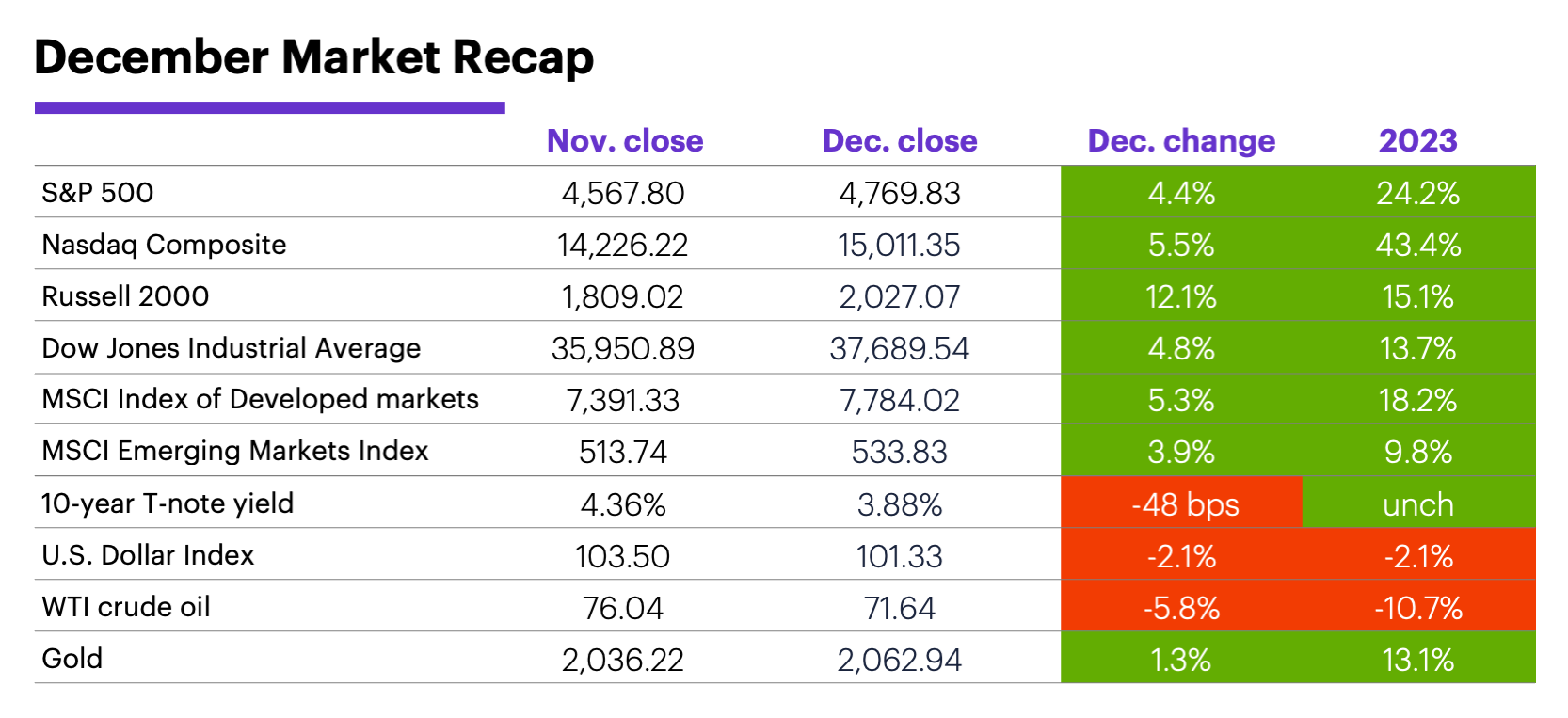Market enters 2024 on a high
E*TRADE from Morgan Stanley
The strongest December since 2010 helped the US stock market wrap up 2023 with the majority of the major indexes at or near all-time highs—no small feat, given some of the benchmarks were in the red for the year as recently as late October and early November.
But after its second-biggest November-December rally of the past six decades, the S&P 500 ended 2023 with a much-better-than-average 24.2% return, while the tech-heavy Nasdaq Composite and the Dow Jones Industrial Average both pushed to all-time highs last month.
December also saw interest rates extend their retreat. The benchmark 10-year T-note yield fell a total of 102 basis points in November and December—more than it has in any two-month period since 2008—to end the year unchanged.
Some previously unloved areas of the market continued to rebound in December. The small-cap Russell 2000 enjoyed its best month since November 2022, while real estate was the strongest S&P 500 sector (+8.7%).

Source (data): Power E*TRADE. (For illustrative purposes. Not a recommendation. It is not possible to invest directly in an index.) Note: Crude oil, gold, and U.S. Dollar Index data reflect spot-market prices. BPS (basis point) = 0.01%.
The question is whether stocks will be able to sustain their momentum in 2024. Last month the market responded favorably to more evidence that inflation, while not fully tamed, is no longer running wild—a development stock investors embraced as a sign that aggressive, market-friendly Fed rate cuts would happen sooner rather than later.
The Fed may indeed be on track to cut rates this year, but Morgan Stanley & Co. analysts think the trimming probably won’t start until June. They expect the Fed to deliver four rate cuts in the second half of 2024, with the potential for another 200 basis points in 2025.1
They also note the potential “downside” of falling inflation is a slowing economy, which could impact the jobs market and consumer spending. That could mean earnings headwinds persist into early 2024, requiring patience and selectivity on the part of stock investors.2 The analysts also argue that global equities, which underperformed the S&P 500 in December and for the year, may be susceptible to a downturn in early 2024.
January has been an up month for the S&P 500 in 10 of the past 20 years, and only four of the past 10.
Geopolitical catalysts—especially elections—may play a bigger role this year than they did last year. In addition to the US, there are as many as 40 elections in key countries this year.3 While Morgan Stanley & Co. economists expect the US to avoid a recession, geopolitical events (including unpredictable elections), could shift investor perceptions about economic growth and the markets.
Insight of the month. As we turn the page to a New Year, artificial intelligence (AI) looks to be as big a story as it was in 2023. Morgan Stanley Wealth Management recently shared their thoughts on the four types of “AI leaders” and how investors can navigate the emerging AI landscape.4
Finally, January may have a reputation as a bullish month for US stocks, but that tendency has been in short supply in recent years. Since 2004, January has been an up month for the S&P 500 half the time, and it was a down month in six of the past 10 years.5
1 MorganStanley.com. Economic Roundtable: What’s in Store for ’24? 12/15/23.
2 MorganStanley.com. 2024 Investment Outlook: Threading the Needle. 11/20/23.
3 MorganStanley.com. The Geopolitical Catalysts That Could Affect Markets in 2024. 12/20/23.
4 MorganStanley.com. Megatrends: How to Invest in the AI Boom. 12/22/23.
5 All figures reflect S&P 500 (SPX) monthly closing prices, 1/2/57–12/31/23. Supporting document available upon request.
Because of their narrow focus, sector investments tend to be more volatile than investments that diversify across many sectors and companies. Technology stocks may be especially volatile. Risks applicable to companies in the energy and natural resources sectors include commodity pricing risk, supply and demand risk, depletion risk and exploration risk. Health care sector stocks are subject to government regulation, as well as government approval of products and services, which can significantly impact price and availability, and which can also be significantly affected by rapid obsolescence and patent expirations.
Yields are subject to change with economic conditions. Yield is only one factor that should be considered when making an investment decision.